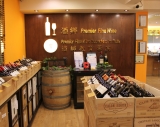First planted to vines in 1890, the Coonawarra district has evolved through three distinct historical periods. The first was the era of the Penola Fruit Colony, and the early settlers such as the Redman family who, by dint of hard work, brought to reality the vision of its Scottish founder, John Riddoch. They generally prospered until the First World War. That era was followed by the troubled times of the Depression and the Second World War. It was during this second period that the original John Riddoch cellars were converted to a distillery, and it was only the Redman family who were able to maintain a continuous tradition of table wine production.
The third historical period witnessed the appreciation by many other investors of the truly great attributes of this small, yet magic tract of terra rossa soil. Samuel Wynn recognised the quality of the wines from the region and, through his purchase of the original cellars in 1951, initiated what was tantamount to a renaissance of the region. It was also during this period that the Australian wine industry--hitherto predominantly fortified--completed the transformation to table wine, and Coonawarra was able to realise its original potential.
The region is only 60 kilometres (37 miles) inland, and a predominantly maritime climate prevails with the dry and moderately cool summers ripening most grape varieties to perfection. But its maritime location does not prevent the occurrence of spring frosts that are occasionally quite severe. When comparisons of climatic statistics are viewed, the Coonawarra climate can resemble that of Bordeaux. However, it is the extensive cloud cover that moderates the most important ripening period temperatures and which sets the region apart from other wine regions.
To the untrained eye, Coonawarra appears completely flat, but in fact the red soil is situated on a slight but all important limestone ridge. It is no accident that the main road passes through its centre, marking the route followed by the bullock drays of the 19th century in their search for firm ground during winter and spring.
The terra rossa of Coonawarra is Australia's most famous soil although it is not unique to the region (many parts of the Limestone Coast Zone have similar soils, hence its name), nor is it of volcanic origin, as some believe. Vivid red in colour, it is either friable subplastic clay or a shallow friable loam derived from and lying on top of a bed of soft limestone. There are two other soils present in the region. The first is the groundwater or black rendzina soil lying to the west of the limestone ridge. Because of its poor drainage this soil does not favour the production of quality red wine fruit. The other is the brown rendzina or ‘transitional’ as it is called in the region. This is similar to terra rossa in all respects and is planted to red grapes quite successfully.
Info: Australian Wine & Brandy Corporation www.wineaustralia.com












